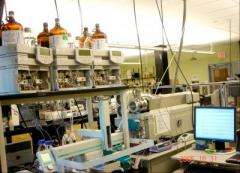Detailed metabolic profile gives 'chemical snapshot' of the effects of exercise

Chemically speaking, you become a different person when you run, according to new research that maps how chemicals change in the blood during exercise, the May 26 issue of Science Translational Medicine reports.
Using a system that analyzes blood samples with unprecedented detail, a team led by Massachusetts General Hospital (MGH) researchers has developed the first "chemical snapshot" of the metabolic effects of exercise. Their findings, reported in the May 26 issue of Science Translational Medicine, may improve understanding of the physiologic effects of exercise and lead to new treatments for cardiovascular disease and diabetes.
"We found new metabolic signatures that clearly distinguish more-fit from less-fit individuals during exercise," says Gregory Lewis, MD, of the MGH Heart Center, the paper's lead author. "These results have implications for the development of optimal training programs and improved assessment of cardiovascular fitness, as well as for the development of nutritional supplements to enhance exercise performance."
The beneficial health effects of exercise - including reducing the risk of heart disease, stroke and type 2 diabetes - are well known, but the biological mechanisms underlying those effects are unclear. Previous investigations of exercise-induced changes in metabolites - biological molecules produced in often-minute quantities - have focused on the few molecules measured by most hospital laboratories. Using a new mass-spectrometry-based system that profiles more than 200 metabolites at a time - developed in collaboration with colleagues from the Broad Institute of Harvard and MIT, led by Clary Clish, PhD - the MGH-based team analyzed blood samples taken from healthy participants before, immediately following, and one hour after exercise stress tests that were approximately 10 minutes long.
Exercise-associated changes were seen in more than 20 metabolites, reflecting processing of sugars, fats and amino acids as fuels as well as the body's utilization of ATP, the primary source of cellular energy. Several changes involved metabolic pathways not previously associated with exercise, including increases in niacinamide, a vitamin derivative known to enhance insulin release. Another experiment that analyzed samples taken from different vascular locations indicated that most metabolite changes were generated in the exercising muscles, although some appeared to arise throughout the body. In both experiments, several metabolite changes persisted 60 minutes after exercise had ceased.
In an experiment designed to assess the effects of prolonged exercise, pre- and post-race samples were taken from 25 runners who completed the 2006 Boston Marathon. Extensive changes in several metabolites - some different from those produced by brief exercise - were seen in the post-race samples. Indicators of increased metabolism of fats, glucose and other carbohydrates rose in response to both brief and prolonged exercise, but in marathoners amino acid levels also fell significantly, reflecting their use of amino acids as fuel to maintain adequate glucose levels during extended exercise.
The researchers also analyzed how these metabolite changes related to participants' level of fitness - determined by peak oxygen uptake in the short-term experiments and by finishing times for the marathon runners. In both groups they found that several changes, including those reflecting increased fat metabolism, were more pronounced in participants who were more fit.
Pursuing the hypothesis that metabolites which increase in response to exercise act on pathways involved in cellular respiration and glucose utilization, the investigators applied different combinations of metabolites to cultured muscle cells. They found that a combination of five molecules increased expression of nur77, a gene recently shown to regulate glucose levels and lipid metabolism, making it a possible treatment target for the combination of cardiovascular risk factors known as metabolic syndrome. The association of nur77 levels with exercise was supported by an experiment that found gene expression increased fivefold in the muscles of mice that had exercised for 30 minutes.
"Our results have implications for development of both diagnostic testing to track and improve exercise performance and for interventions to reduce the effects of diabetes or heart disease by improving a patient's metabolic 'fingerprint'," explains Robert Gerszten, MD, director of Clinical and Translational Research at the MGH Heart Center, the study's senior author. "Improving the health of people with cardiovascular disease is our number one goal, but defining which metabolites become deficient and need to be replenished during exercise could also lead to the next generation of sports drinks that can help healthy individuals achieve their best exercise performance."















